中国传统建筑介绍[英文]
故宫建筑简要介绍英文作文

故宫建筑简要介绍英文作文英文:The Forbidden City, also known as the Palace Museum, is a magnificent complex of imperial palaces and gardens located at the heart of Beijing, China. Built during the Ming and Qing dynasties, it served as the imperial palace for emperors and their households for over 500 years.The Forbidden City covers an area of 720,000 square meters and contains over 9,000 rooms. Its architecture is a perfect example of traditional Chinese palace design, with its red walls, yellow glazed roof tiles, and intricate decorations. The buildings are arranged along a central axis, with the main gate, the Meridian Gate, at the southern end and the Imperial Garden at the northern end.One of the most impressive features of the Forbidden City is its collection of cultural relics. There are over 1.8 million items in the Palace Museum, including ancientbooks, paintings, calligraphy, and ceramics. These treasures provide a glimpse into the rich history and culture of China.中文:故宫,又称为故宫博物院,是位于中国北京市中心的一座宏伟的皇家宫殿和花园群。
中国建筑英语介绍文章范文阅读

中国建筑英语介绍文章范文阅读中国古典建筑算是举世闻名的,如今独具特色的新建筑物也犹如雨后春笋般地出现。
今天店铺整理了介绍中国建筑的英语文章,希望大家喜欢!介绍中国建筑的英语文章篇一The Ancient Architecture中国古代建筑艺术Chinese architecture is an independent art featuring wooden structures. It consists of various roof molding, upturned eaves and wings, dougong with paintings, vermilion pillars and golden roofs, ornament gates and gardening. All of these embody the maturity and artistic appeal of Chinese architecture. 7000 years ago, mortise and tenon and tongue-and-groove were used in Hemudu. The buildings of Banpo village had the division of antechamber and back rooms. Great palaces were built in Shangyin period. Bricks and tiles were used and the layout of Siheyuan emerged in the Western Zhou. There are even building drawings in Spring and Autumn and the Warring States periods passed down.中国建筑体系是以木结构为特色阳的建筑艺术。
中国传统房子介绍英文作文
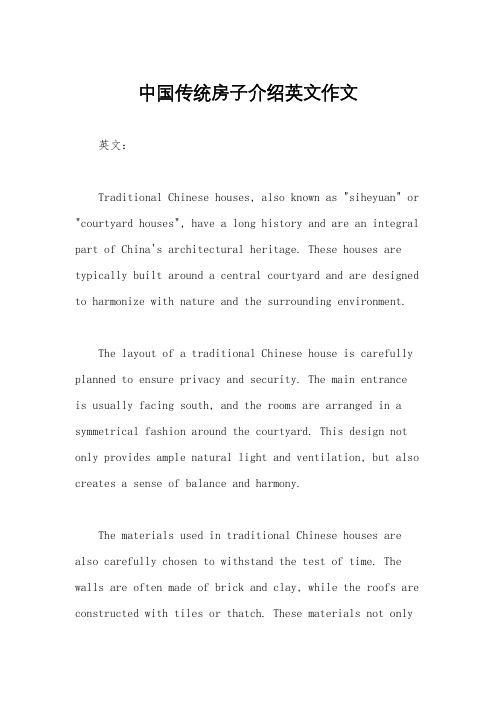
中国传统房子介绍英文作文英文:Traditional Chinese houses, also known as "siheyuan" or "courtyard houses", have a long history and are an integral part of China's architectural heritage. These houses are typically built around a central courtyard and are designed to harmonize with nature and the surrounding environment.The layout of a traditional Chinese house is carefully planned to ensure privacy and security. The main entranceis usually facing south, and the rooms are arranged in a symmetrical fashion around the courtyard. This design not only provides ample natural light and ventilation, but also creates a sense of balance and harmony.The materials used in traditional Chinese houses are also carefully chosen to withstand the test of time. The walls are often made of brick and clay, while the roofs are constructed with tiles or thatch. These materials not onlyprovide insulation and protection from the elements, but also give the houses a timeless and elegant appearance.In addition to their practical design, traditional Chinese houses also reflect the cultural values and beliefs of the people. For example, the use of auspicious symbols and motifs in the architectural details, such as dragon carvings and intricate woodwork, is believed to bring good luck and prosperity to the occupants.Furthermore, traditional Chinese houses are designed to accommodate the needs of a multi-generational family. The layout of the rooms and the communal courtyard provide ample space for family gatherings and activities, fostering a sense of unity and togetherness.Overall, traditional Chinese houses are not just architectural marvels, but also a reflection of the rich cultural heritage and values of the Chinese people.中文:中国传统房屋,也被称为“四合院”,有着悠久的历史,是中国建筑遗产的重要组成部分。
中国传统建筑英文介绍

Japanese Tea House
The path of a Japanese Tea Garden is flanked by lovely white birch trees. These tea houses are used on special, usually spiritual occasions with hosts and guests. In the front, there are also sliding shoji doors, but the guests of the tea party enter through the left side entrance called the low nijiriguchi, which makes them kneel when they come through the door, showing humbleness.
This is what they used to plan The Temple of Heaven out. (The out-line)
Book Source: Chinese Architecture by Laurence G. Liu
The Great Wall of China was built over 2,000 years ago, by Qin Shi Huangdi (10,000 Li = about 5,000 km). After subjugating and uniting China, the emperor started to build the Great Wall to stop the foreign enemies from invading China. The Great Wall extends across the mountains of northern China. It’s constructed of masonry, rocks, and packed-earth. During the Ming Dynasty (13681644), the Great Wall was enlarged to 6,400 kilometers (4,000 miles) and renovated over a 200-year period. The Great Wall is the largest construction project ever completed in the whole wide world. /china.wallshot.jpg
中国传统房子介绍英文作文

中国传统房子介绍英文作文Title: Exploring Traditional Chinese Houses: A Glimpse into Cultural Richness。
1. Embracing the Spirit of Ancient Wisdom (Unconventional Introduction)。
In the realm of architectural wonders, Chinese houses stand as a testament to the profound wisdom of our ancestors. These dwellings, far from being mere structures, embody the essence of Feng Shui, a holistic philosophy that harmonizes with nature.2. A Symphony of Wood and Stone (Material and Design)。
Each brick and beam whispers the story of time, crafted from the sturdy heartwood of ancient trees. Their walls, adorned with intricate carvings, are a living canvas of calligraphy and dragon motifs, reflecting the cultural tapestry. The roofs, sloping gracefully, protect the homewith their thatched or tile covers, echoing the changing seasons.3. The Art of Space and Light (Functionality)。
中国传统民居英文介绍

security
axisymmetric
quadrangle dwelling
feudal ethics
Cave Dwelling
warm in winter cool in summer
窑洞
insect-resistant flood-fighting
Guangxi "pole-railing" style houses
Chinese traditional dwellings
Reporter : Jasmine Date : China Arbor Day
Chinese tranity of heaven and man yin-yang in good order
hakka RoundDragon House
Current situation and development
regionalism \ cultural property \ epochal character
地域性 文化性 时代性
点击添加文本 Thanks for your attentions
Answer
1.They are Round-Dragon Houses、Beijing quadrangle dwellings、Shannxi cave dwellings , Guangxi "pole-railing" style houses and Yunnan Yikeyin Dwellings respectively.
广西“栏杆式”
moistureproof ventilation and heat rejection
seal wingroom principal room front door
中国传统建筑风格中英双语介绍

Ancient architecture continued in Yuan Dynasty, especially the Islamic mosques and Buddhist temples, which brought deep influence on the Han national architecture. In the Ming and the Qing dynasties, architecture reached its climax. The Qing Dynasty compiled another book Gong Zheng Zuo Fa Tse Li. It was the government manual to standardize architecture.
The Categories of Ancient Architecture
Generally, Chinese ancient architecture consists of government architecture and civil architecture. The former includes the imperial palaces, mausoleum, Buddhist temples, Taoist guan, altars, gardens and other big buildings.
Paifang and Cloud Pillar仿表
(十)坊表
中国古代具有表彰、 纪念、导向或标志作 用的建筑物,包括牌 坊、华表等
(一)中国建筑的色调
中国古代建筑的色彩非常丰富。有的色 调鲜明,对比强烈,有的色调和谐,纯 朴淡雅。建筑师根据不同需要和风俗习 尚而选择施用。大凡宫殿、坛庙、寺观 等建筑物多使用对比强烈,色调鲜明的 色彩:红墙黄瓦(或其他颜色的瓦)衬 托着绿树蓝天,再加上檐下的金碧彩画, 使整个古建筑显得分外绚丽。在表现中 国古建筑艺术的特征中,琉璃瓦和彩画 是很重要的两个方面。
英文介绍古建筑

英文介绍古建筑Ancient architecture is a reflection of a society's culture, history, and technological advancements. These structures have withstood the test of time, showcasing the craftsmanship and architectural ingenuity of past civilizations. From the Great Pyramids of Giza in Egypt to the Parthenon in Greece, ancient architecture continues to captivate and inspire people around the world.One of the defining features of ancient architecture is its use of natural materials such as stone, wood, and clay. These materials were readily available and were often used in their raw form, showcasing the simplicity and beauty of the natural world. The use of these materials also allowed ancient architects to create durable and long-lasting structures that have stood for centuries.Ancient architecture is also characterized by its intricate detailing and decorative elements. From intricate carvings on stone temples to colorful frescoes adorningwalls, ancient architects paid meticulous attention to detail, creating visually stunning structures that were not only functional but also aesthetically pleasing. These decorative elements often told stories of the society's beliefs, myths, and values, providing valuable insightsinto their culture and way of life.Furthermore, ancient architecture often incorporated advanced engineering techniques that were ahead of their time. From the use of arches and domes to sophisticated water management systems, ancient architects demonstrated a deep understanding of mathematics, physics, and construction principles. These innovations not only enhanced the functionality of the structures but also showcased the intellectual prowess of the civilizationsthat built them.Another significant aspect of ancient architecture is its spiritual and religious significance. Many ancient structures were built as temples, tombs, or sacred sites, serving as places of worship and reverence for the society. The design and orientation of these structures were oftenaligned with astronomical phenomena or religious beliefs, creating a sense of harmony and connection with the divine.In conclusion, ancient architecture is a testament to the creativity, skill, and vision of past civilizations. These structures continue to inspire awe and admiration, serving as a reminder of the rich cultural heritage and architectural legacy of our ancestors. By studying and preserving ancient architecture, we not only gain a deeper understanding of the past but also ensure that these architectural marvels continue to be appreciated and cherished for generations to come.。
中国传统建筑 作文英文

中国传统建筑作文英文English:Chinese traditional architecture, characterized by exquisite craftsmanship, intricate wooden structures, and harmonious integration with nature, reflects the unique cultural identity and philosophical beliefs of the Chinese people. From ancient palaces like the Forbidden City to traditional courtyard houses, each building is carefully designed to adhere to the principles of feng shui and yin-yang balance. The use of natural materials like wood, stone, and ceramic tiles not only enhances the aesthetic appeal but also demonstrates a deep respect for the environment. Additionally, traditional Chinese architecture often features curved eaves, decorative motifs like dragons and phoenixes, and intricate lattice windows, all of which symbolize wealth, prosperity, and protection. Moreover, the layout of traditional Chinese buildings follows a symmetrical and hierarchical structure, with the emphasis on creating a harmonious flow of energy known as qi. Overall, Chinese traditional architecture embodies a rich heritage of architectural wisdom and cultural symbolism that continues to inspire generations of architects and designers worldwide.Translated content:中国传统建筑以精湛的工艺、错综复杂的木质结构和与自然的和谐融合为特征,体现了中国人民独特的文化认同和哲学信仰。
中国传统建筑的特点及代表性建筑的英语作文

中国传统建筑的特点及代表性建筑的英语作文English:Chinese traditional architecture is characterized by its emphasis on harmony with nature, symmetry, and grandeur. The use of wooden structures, intricate carvings, and curved roof lines are common features in traditional Chinese buildings. One of the most iconic examples of traditional Chinese architecture is the Forbidden City in Beijing, which was the imperial palace during the Ming and Qing dynasties. The complex is comprised of numerous halls, pavilions, and courtyards, showcasing the intricate craftsmanship and detailed designs that are synonymous with Chinese architecture. Another famous example is the Temple of Heaven, also located in Beijing, which was used by emperors to pray for good harvests and peace in ancient times. The temple's circular design and its precise layout symbolize the connection between heaven and earth in Chinese cosmology. Overall, Chinese traditional architecture reflects the country's rich cultural heritage and architectural achievements throughout history.中文翻译:中国传统建筑以与自然的和谐、对称和宏伟为特点。
中国传统建筑介绍英语作文
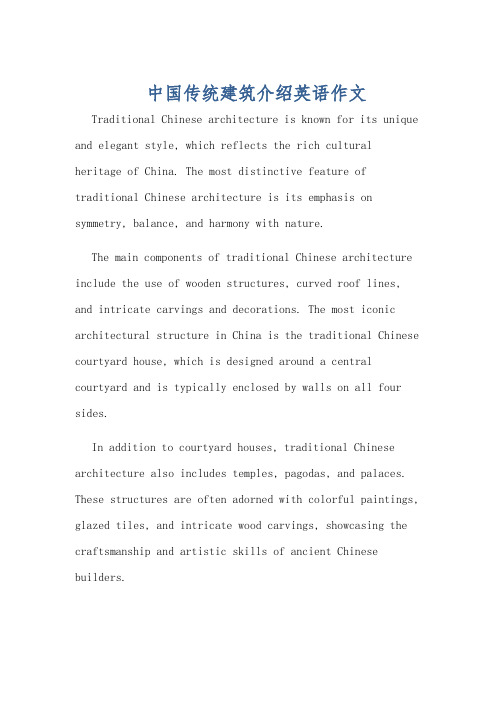
中国传统建筑介绍英语作文Traditional Chinese architecture is known for its unique and elegant style, which reflects the rich cultural heritage of China. The most distinctive feature of traditional Chinese architecture is its emphasis on symmetry, balance, and harmony with nature.The main components of traditional Chinese architecture include the use of wooden structures, curved roof lines, and intricate carvings and decorations. The most iconic architectural structure in China is the traditional Chinese courtyard house, which is designed around a central courtyard and is typically enclosed by walls on all four sides.In addition to courtyard houses, traditional Chinese architecture also includes temples, pagodas, and palaces. These structures are often adorned with colorful paintings, glazed tiles, and intricate wood carvings, showcasing the craftsmanship and artistic skills of ancient Chinese builders.The use of feng shui principles is also an important aspect of traditional Chinese architecture, as buildingsare often positioned and designed to harmonize with the surrounding environment and promote positive energy flow.Overall, traditional Chinese architecture is a testament to the ingenuity and creativity of ancient Chinese builders, and it continues to inspire and influence modern architectural designs.中国传统建筑以其独特和优雅的风格而闻名,反映了中国丰富的文化遗产。
中国文化之-建筑(中英文)

the use of cloud computing technology to collect and analyze data from various building systems, providing
decision support for building management.
Water conservation
the use of water-saving technologies and devices to reduce water consumption in buildings, such as low-flow faucets and water-saving toilets.
Respect for human needs
the design of buildings should respect human needs and preferences, providing comfortable and convenient living spaces.
Inቤተ መጻሕፍቲ ባይዱegration of traditional culture
Promotion of intelligent buildings
Smart sensors
the application of smart sensors in buildings to monitor and control building systems, such as lighting, air conditioning and security.
雕刻是中国传统建筑中最为常见的装饰形式之一,包括木 雕、石雕、砖雕等。雕刻的题材广泛,包括花卉、动物、 人物等,通过雕刻可以表现出极高的艺术价值和深厚的文 化底蕴。
中国传统建筑介绍英语作文

中国传统建筑介绍英语作文Traditional Chinese Architecture: A Glimpse into the Soulof Ancient ChinaChina, a land rich in history and culture, is home to someof the most extraordinary traditional architecture in the world. These remarkable structures not only reflect the splendid craftsmanship and architectural genius of ancient Chinese civilization but also hold immense cultural significance. From majestic palaces to serene temples, Chinese traditional architecture is a testament to the country's profound heritage and exceptional wisdom.One iconic example of traditional Chinese architecture isthe Forbidden City, located in Beijing. This magnificent palace complex served as an imperial residence for overfive centuries and was home to several emperors of the Ming and Qing dynasties. The grandeur of its towering red walls, intricately carved wooden roofs, and meticulously designed courtyards capture China's imperial history in every detail.Another must-see architectural masterpiece is the Great Wall of China. Snaking across mountains and valleys for thousands of kilometers, this colossal structure stands as a symbol of strength, determination, and resilience. Built to protect China from invaders during various dynasties, each brick used in constructing this engineering marvel carries a weighty historical legacy.In addition to grand palaces and formidable walls, traditional Chinese architecture also encompasses elegant Buddhist temples that blend harmony with nature. For instance, the White Horse Temple in Luoyang stands as one of China's oldest Buddhist temples. Its exquisite design features intricate stone carvings depicting stories from Buddhism's vast scriptures. The temple's peaceful atmosphere transports visitors into a realm where ancient wisdom meets tranquility.The Yingxian Wooden Pagoda is another remarkable example that showcases the sophistication of traditional Chinese architecture. Located in Shanxi Province, this pagoda dates back over 900 years and boasts its original woodenstructure without any nails or cement holding it together. Its intricate yet stable design is a testament to the brilliance of ancient Chinese carpentry techniques.Chinese gardens are yet another striking aspect of traditional Chinese architecture. The classical gardens in Suzhou, such as the Humble Administrator's Garden and Lingering Garden, exemplify the concept of harmonious coexistence between humans and nature. These artfully designed landscapes feature meandering paths, elegant pavilions, serene ponds, and carefully selected vegetation, creating a tranquil oasis that invites contemplation and tranquility.What truly sets Chinese traditional architecture apart is its deep-rooted symbolism. Every architectural element carries hidden meanings that embody philosophical concepts like feng shui and yin-yang harmony. For instance, the curvature of a roof represents an upwardly rising dragon bringing fortune and protection to the building.In conclusion, exploring traditional Chinese architectureoffers a tangible connection to ancient China's rich heritage. From the awe-inspiring Forbidden City and Great Wall to the serene Buddhist temples and harmonious gardens, these architectural wonders reflect the depths of wisdom and cultural traditions inherent in Chinese history. Through their intricate designs, unique construction methods, and profound symbolism, traditional Chinese buildings provide a lasting testament to the sophistication of ancient Chinese civilization. So next time you encounter one of these magnificent structures, remember it is not merely a physical edifice but also a gateway into the soul of ancient China itself.。
介绍中国传统建筑的英语作文

介绍中国传统建筑的英语作文{z}Title: Traditional Chinese Architecture: A Glimpse into Historical CivilizationTraditional Chinese architecture is a remarkable reflection of the rich and diverse history of China, showcasing a unique blend of cultural, artistic, and philosophical elements.From the grand palaces to the humble farmhouses, these structures bear testament to the intricate designs and innovative engineering techniques that have been passed down through generations.One of the most iconic and representative forms of traditional Chinese architecture is the Pagoda.Pagodas are multi-tiered towers, typically built with wood, bricks, or stone, and are often adorned with intricate carvings and painted in vibrant colors.These architectural marvels were primarily built for religious purposes, as a place for worship or as a repository for sacred scriptures.The pagoda"s design, with its slanted roofs and tiered structure, symbolizes the hierarchy and order of the universe, as well as the Buddhist concept of reaching enlightenment through ascending different levels.Another distinctive feature of traditional Chinese architecture is the use of the Hip-gable roof.This roof style, characterized by its upward curve at theends and central peak, is not only visually appealing but also serves practical purposes.The unique structure of the Hip-gable roofallows for better drainage of rainwater and provides increased stability to the building.Additionally, the roof is often adorned with intricate decorations such as ceramic tiles, wooden carvings, and even mythical creatures, symbolizing good fortune and protection.The Forbidden City, located in the heart of Beijing, is perhaps the most famous example of traditional Chinese architecture.It is a vast complex of palaces, temples, and gardens, built over a span of 400 years.The city"s design follows the traditional Chinese philosophy of balance and harmony, with its north-south axis symbolizing the cosmic order.The use of yellow, the imperial color, is prominent in the Forbidden City, signifying power, wealth, and status.Traditional Chinese architecture is also characterized by its use of intricate woodwork and joinery techniques.wooden structures are often connected without the use of nails, relying on precise cuts and interlocking components to hold the building together.This not only showcases the high level of craftsmanship but also allows for greater flexibility and resilience in the structure.In conclusion, traditional Chinese architecture is a testament to the ingenuity and artistic prowess of ancient Chinese civilization.With its unique designs, symbolic meanings, and innovative engineering techniques, it continues to inspire and captivate people around the world.。
中国传统建筑 作文英文
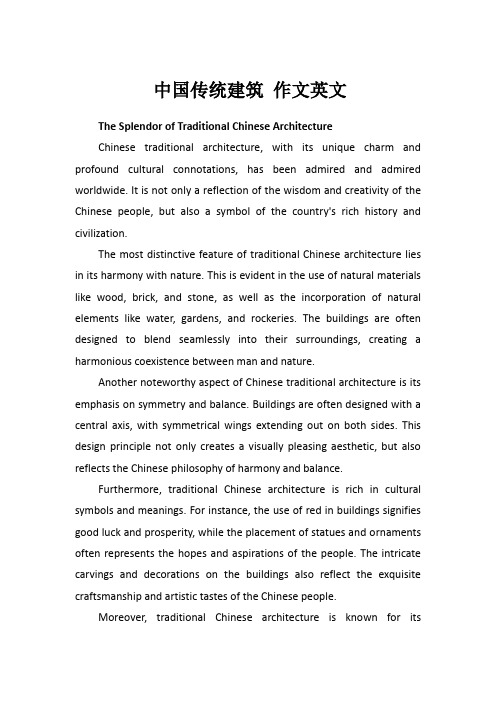
中国传统建筑作文英文The Splendor of Traditional Chinese ArchitectureChinese traditional architecture, with its unique charm and profound cultural connotations, has been admired and admired worldwide. It is not only a reflection of the wisdom and creativity of the Chinese people, but also a symbol of the country's rich history and civilization.The most distinctive feature of traditional Chinese architecture lies in its harmony with nature. This is evident in the use of natural materials like wood, brick, and stone, as well as the incorporation of natural elements like water, gardens, and rockeries. The buildings are often designed to blend seamlessly into their surroundings, creating a harmonious coexistence between man and nature.Another noteworthy aspect of Chinese traditional architecture is its emphasis on symmetry and balance. Buildings are often designed with a central axis, with symmetrical wings extending out on both sides. This design principle not only creates a visually pleasing aesthetic, but also reflects the Chinese philosophy of harmony and balance.Furthermore, traditional Chinese architecture is rich in cultural symbols and meanings. For instance, the use of red in buildings signifies good luck and prosperity, while the placement of statues and ornaments often represents the hopes and aspirations of the people. The intricate carvings and decorations on the buildings also reflect the exquisite craftsmanship and artistic tastes of the Chinese people.Moreover, traditional Chinese architecture is known for itsemphasis on functionality and practicality. Buildings are designed to meet the needs of the people, whether it's for living, working, or worshipping. The layout and design of the buildings take into account the climate, environment, and lifestyle of the inhabitants, ensuring that they are comfortable and convenient to use.In conclusion, traditional Chinese architecture is a treasure of the Chinese nation. It not only showcases the wisdom and creativity of the Chinese people, but also embodies the country's rich history and culture. As we move forward into the future, it is important to preserve and promote this valuable cultural heritage, so that it can continue to inspire and influence people worldwide.。
介绍中国祠堂文化英语作文

介绍中国祠堂文化英语作文英文:China has a rich cultural heritage, and one aspect of this is the tradition of ancestral halls, or "祠堂"(cítáng) in Chinese. Ancestral halls are an important part of Chinese culture and are often found in villages and towns throughout the country. These halls are used to honor and worship ancestors, and they play a significant role in the lives of Chinese people.Ancestral halls are typically built in a traditional Chinese architectural style, with intricate carvings, colorful paintings, and beautiful courtyards. They are often the most well-preserved and exquisite buildings in a village or town, and they serve as a symbol of the community's history and heritage.In addition to their architectural significance, ancestral halls are also important social and culturalcenters. They are often used for community gatherings, festivals, and important ceremonies. For example, during the Chinese New Year, families will gather at the ancestral hall to pay respects to their ancestors and seek blessings for the coming year. These halls also serve as a place for the community to come together and celebrate important milestones, such as weddings and funerals.Ancestral halls also play a crucial role in preserving and passing down traditional Chinese values and customs. Through the worship of ancestors and the practice of traditional rituals, Chinese people are able to maintain a strong connection to their cultural roots and heritage. This helps to foster a sense of unity and belonging within the community, and it ensures that important cultural traditions are preserved for future generations.Overall, ancestral halls are a vital part of Chinese culture, serving as both a physical representation of the community's history and a social and cultural hub for its people.中文:中国有着丰富的文化遗产,其中之一就是祠堂传统。
介绍中国传统建筑的英语作文

介绍中国传统建筑的英语作文English:Traditional Chinese architecture is characterized by its unique style, elaborate wooden structures, and emphasis on harmony with nature. The most iconic feature of traditional Chinese architecture is the curved and sloping roofs, which are often adorned with intricate carvings and colorful tiles. The wooden columns and beams are also meticulously crafted to create a sense of grace and beauty. Traditional Chinese buildings are typically designed around a central courtyard, with rooms arranged in a symmetrical layout. This layout not only maximizes natural light and ventilation but also promotes a sense of balance and harmony. Additionally, traditional Chinese architecture often incorporates elements of feng shui to create a harmonious and auspicious living environment. Overall, traditional Chinese architecture reflects the cultural values of balance, harmony, and beauty.中文翻译:传统的中国建筑以其独特的风格、精美的木制结构和强调与自然和谐的特点而闻名。
客家土楼英文介绍
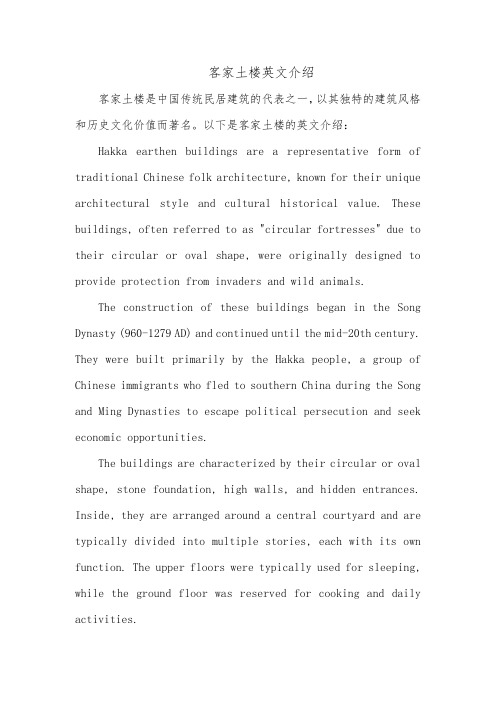
客家土楼英文介绍客家土楼是中国传统民居建筑的代表之一,以其独特的建筑风格和历史文化价值而著名。
以下是客家土楼的英文介绍:Hakka earthen buildings are a representative form of traditional Chinese folk architecture, known for their unique architectural style and cultural historical value. These buildings, often referred to as "circular fortresses" due to their circular or oval shape, were originally designed to provide protection from invaders and wild animals.The construction of these buildings began in the Song Dynasty (960-1279 AD) and continued until the mid-20th century. They were built primarily by the Hakka people, a group of Chinese immigrants who fled to southern China during the Song and Ming Dynasties to escape political persecution and seek economic opportunities.The buildings are characterized by their circular or oval shape, stone foundation, high walls, and hidden entrances. Inside, they are arranged around a central courtyard and are typically divided into multiple stories, each with its own function. The upper floors were typically used for sleeping, while the ground floor was reserved for cooking and daily activities.Hakka earthen buildings are an important part of Chinese cultural heritage and have been designated as national cultural relics. In addition to their historical value, they also serve as a symbol of traditional Chinese culture and are an important part of many tourist itineraries in China.。
中国传统房子介绍英文作文
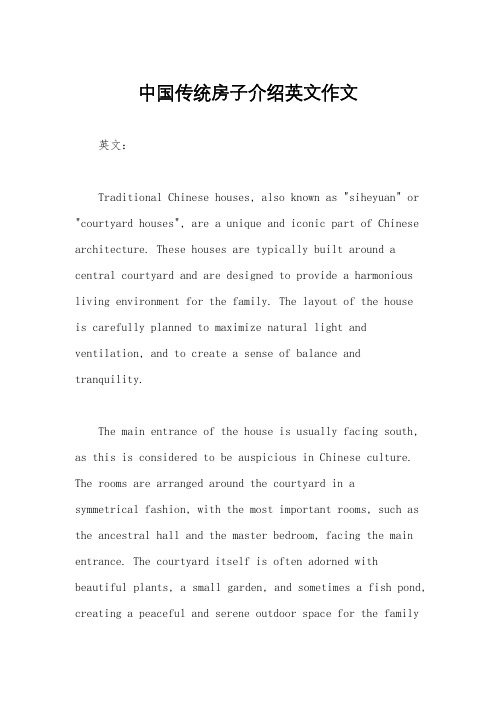
中国传统房子介绍英文作文英文:Traditional Chinese houses, also known as "siheyuan" or "courtyard houses", are a unique and iconic part of Chinese architecture. These houses are typically built around a central courtyard and are designed to provide a harmonious living environment for the family. The layout of the houseis carefully planned to maximize natural light and ventilation, and to create a sense of balance and tranquility.The main entrance of the house is usually facing south, as this is considered to be auspicious in Chinese culture. The rooms are arranged around the courtyard in asymmetrical fashion, with the most important rooms, such as the ancestral hall and the master bedroom, facing the main entrance. The courtyard itself is often adorned with beautiful plants, a small garden, and sometimes a fish pond, creating a peaceful and serene outdoor space for the familyto enjoy.One of the most distinctive features of traditional Chinese houses is the use of "hutongs", which are narrow alleys or streets that connect the courtyard houses to each other. These hutongs are not only a means of transportation, but also serve as social spaces where neighbors caninteract and children can play. The sense of community and connection that is fostered in these hutongs is an integral part of the traditional Chinese way of life.In addition to their architectural significance, traditional Chinese houses also reflect the values and beliefs of the Chinese people. The emphasis on harmony, balance, and respect for tradition is evident in every aspect of the design and construction of these houses. For example, the use of certain materials, such as wood andclay tiles, is believed to bring good fortune andprosperity to the family.Overall, traditional Chinese houses are not just buildings, but a reflection of the rich cultural heritageand the deep-rooted traditions of the Chinese people. They embody the principles of feng shui, the importance offamily and community, and the timeless beauty of Chinese architecture.中文:中国传统房子,也被称为“四合院”或“庭院房”,是中国建筑的独特和标志性部分。
介绍中国传统建筑的英语作文

Exploring the Enchanting Architecture ofChinaNestled within the heart of the Orient, China boasts a rich and diverse architectural heritage that spans across centuries. Its traditional buildings, often regarded as the silent witnesses of history, stand as testament to the country's profound cultural values and aesthetic sensibilities. From the opulent palaces of the imperial era to the serene temples hidden in the folds of the mountains, Chinese architecture tells a story of grandeur, elegance, and harmony with nature.The essence of Chinese architecture lies in its symmetry and balance. This is particularly evident in the design of temples and palaces, where every detail, from the positioning of doors and windows to the intricate carvings adorning the façades, is carefully planned to achieve a sense of harmony and unity. The use of vibrant colors and intricate designs not only enhances the visual appeal of these structures but also reflects the cultural values and beliefs of the people.One of the most striking features of Chinese architecture is the roof, often adorned with elaboratetiles and curved eaves. These roofs, with their unique shapes and designs, not only provide protection from the elements but also serve as aesthetic highlights, adding a touch of elegance and dignity to the overall structure. The use of wood as the primary material for construction is another distinctive characteristic of Chinese architecture. Wood, being a flexible and durable material, allows for intricate carvings and detailed designs, further enhancing the aesthetic appeal of these buildings.In addition to its visual beauty, Chinese architecture also embodies a deep sense of philosophical and religious beliefs. Many temples and palaces are designed to align with the natural landscape, symbolizing a harmonious coexistence with nature. This philosophy of "harmony with nature" is further reflected in the use of natural materials and the integration of indoor and outdoor spaces, creating a seamless connection between the building and its surroundings.Moreover, Chinese architecture is not just about physical structures; it is also about creating a sense of community and belonging. Public spaces like temples and marketplaces serve as gathering points for people,fostering social interactions and cultural exchanges. In this way, Chinese architecture not only preserves the country's rich cultural heritage but also plays a crucial role in shaping its social fabric.In conclusion, the traditional architecture of China is a testament to the country's rich cultural heritage and aesthetic sensibilities. Its symmetry, elegance, and harmony with nature make it a unique and enchanting form of architecture that continues to captivate and inspire people from all over the world. As we delve deeper into the intricate details of Chinese architecture, we are not just admiring its beauty but also understanding the deep-rooted cultural values and beliefs that have shaped this remarkable architectural legacy.**探索中国传统建筑的魅力**位于中国的心脏地带,中国拥有丰富的、多样化的建筑遗产,这些遗产跨越了数个世纪。
- 1、下载文档前请自行甄别文档内容的完整性,平台不提供额外的编辑、内容补充、找答案等附加服务。
- 2、"仅部分预览"的文档,不可在线预览部分如存在完整性等问题,可反馈申请退款(可完整预览的文档不适用该条件!)。
- 3、如文档侵犯您的权益,请联系客服反馈,我们会尽快为您处理(人工客服工作时间:9:00-18:30)。
礼仪
Fengshui is universally used in Chinese people’s life, such as ritual, behavior, architecture…… Its idea, harmony, is rooted in Taoism, China’s local philosophy. We can even say that we can see this idea everywhere in Chinese architecture.
Appreciate Chinese Architecture
Summer Palace
From Internet
Summer Palace
From Internet
Humble Administrator's Garden
From Internet
谦逊的
Beijing Quadrangle
Copyright © 2014 Zhu Yixin. All rights reserved.
Forbidden City
© 2014 Zhu Yixin
Enclosed Space
Feature 1
From the map of Forbidden City, we can see a square palace city surrounded by the palace wall. 封闭的
对称的
轴线
Focusing on Fengshui
Feature 3
From the map of Forbidden City, we can see the palace city is also surrounded by a river that represents the forbidden city is the source of dragon, the emperor.
Symmetrical Space
Feature 2
From the map of Forbidden City, we can see the palaces are built according to the central axis representing the power of emperor and his empire.
From Internet
Zhou Zhuang
From Internet
THANK YOU !
Nanyue Hengshan
© 2013 Zhu Yixin
Group Mห้องสมุดไป่ตู้mbers
朱溢鑫 兰俊 李淼 罗雄 卓子翔
Zhu Yixin Lan Jun Li Miao Luo Xiong Zhuo Zixiang
Class13-3, Department of Finance
CE, HUNAU
A Symbol of Chinese Culture
Chinese Architecture
